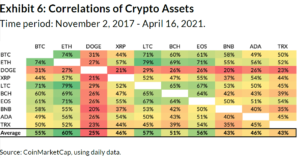Order Cryptocurrencies Rapidly and Firmly: Relied On Platforms and Approaches
Order Cryptocurrencies Rapidly and Firmly: Relied On Platforms and Approaches
Blog Article
The Future of Cryptocurrencies: Fads to Enjoy in the Coming Years
As we look ahead, the landscape of cryptocurrencies is going through extensive changes affected by a number of key fads. The introduction of Central Financial institution Digital Currencies (CBDCs) stands to redefine the combination of digital assets within standard monetary systems, while boosted governing analysis may form the functional landscape for cryptocurrencies. Furthermore, the development of decentralized finance (DeFi) and the growing value of non-fungible tokens (NFTs) assure to modify perceptions of possession and evaluation in an electronic economy. These developments raise crucial concerns regarding the future trajectory of cryptocurrencies and their function in our monetary environment.
Rise of Central Bank Digital Currencies
The introduction of Reserve bank Digital Currencies (CBDCs) represents a considerable shift in the monetary landscape as federal governments check out electronic options to conventional fiat money. These state-backed electronic money aim to improve the efficiency of payment systems, advertise monetary incorporation, and offer a safe and secure alternative to exclusive cryptocurrencies. Unlike decentralized digital currencies, CBDCs operate under the auspices of central banks, guaranteeing regulative oversight and security.
Numerous nations are proactively piloting or investigating CBDCs, with significant instances including China's digital yuan and the European Central Financial institution's digital euro campaign. These initiatives highlight an expanding acknowledgment of the potential benefits of digital currencies, such as faster purchase rates and reduced prices related to cross-border repayments. CBDCs can serve as a tool to combat illegal activities by giving better openness in purchases.
As the adoption of CBDCs proceeds, they might reshape consumer behavior and impact worldwide monetary characteristics. However, the change to a digital currency structure presents challenges, consisting of technological infrastructure, cybersecurity worries, and public trust fund. The rise of CBDCs indicates a zero hour that can redefine the function of cash in a significantly electronic economic situation, calling for close monitoring by industry stakeholders and policymakers alike.
Boosted Regulative Analysis

Countries around the world are taking varied methods, from outright bans to regulative sandboxes that allow innovation while guaranteeing compliance. The European Union, as an example, is moving towards extensive legislation with the Markets in copyright-Assets Law (MiCA), targeted at creating a unified approach across member states. In the USA, agencies like the SEC and CFTC are increasingly energetic in providing standards and enforcement activities.
This governing atmosphere is most likely to have significant ramifications for market individuals. Business operating in the copyright area may deal with more stringent conformity demands, which could bring about increased operational expenses. However, clear laws can additionally promote higher institutional financial investment, as companies look for to browse a much more defined legal landscape. Ultimately, the balance between innovation and guideline will shape the future of cryptocurrencies.
Advancement of DeFi Operatings Systems
Decentralized Money (DeFi) systems have actually gone through substantial change given that their beginning, reshaping the typical monetary landscape - order cryptocurrencies. These platforms mainly concentrated on straightforward features such as lending and borrowing, assisted in by clever agreements on blockchain networks. Nevertheless, the development of DeFi has actually broadened to incorporate a wide selection of financial solutions, including by-products trading, return farming, and automated market-making.
One of the most notable advancements is the emergence of Layer 2 solutions, which enhance scalability and reduce deal prices, making DeFi more easily accessible to a broader target market. In addition, cross-chain interoperability has ended up being a critical focus, permitting individuals to move assets effortlessly across different blockchain networks. This evolution fosters greater liquidity and customer engagement.
In addition, the combination of advanced administration versions has empowered communities to get involved in decision-making processes, promoting sustainability and technology within the ecological community. As DeFi proceeds to grow, we can expect click further enhancements in individual experience through boosted user interfaces and safety and security steps, addressing problems that have previously impeded mainstream adoption. In general, the trajectory of DeFi systems factors toward a much more comprehensive and efficient financial future, providing choices to conventional financial systems.
Combination of NFTs in Money
In the middle of the rapid development of the monetary landscape, the combination of Non-Fungible Symbols (NFTs) has actually emerged as a transformative pressure. Traditionally connected with electronic art and collectibles, NFTs are currently discovering applications in different monetary markets, introducing cutting-edge methods to represent ownership and value.
One significant location of integration is in realty, where NFTs can enhance residential or commercial property deals. By tokenizing property properties, customers can take pleasure in fractional ownership, minimizing entrance barriers and boosting liquidity. order cryptocurrencies. Furthermore, NFTs can ensure clear and unalterable records of ownership, enhancing trust fund in real estate negotiations
In the globe of money, NFTs are additionally being made use of for decentralized finance (DeFi) applications, allowing collateralization of possessions. By utilizing NFTs as security, consumers can access financings while keeping ownership of their electronic possessions. This capability boosts the ease of access of economic solutions and promotes a much more inclusive economic ecological community.
Additionally, the assimilation of NFTs page into conventional finance could change the means intellectual residential or commercial property rights are managed, providing creators with brand-new earnings streams via clever agreements. On the whole, the combination of NFTs in financing signifies a shift towards even more cutting-edge, efficient, and clear monetary remedies, leading the way for future developments.
Innovations in Blockchain Innovation

One substantial pattern is the appearance of Layer 2 remedies, designed to boost scalability and deal rates, thus dealing with the limitations of main blockchain networks. These solutions enable faster handling of purchases, decreasing fees and increasing efficiency, which is essential for mass fostering.
Moreover, interoperability in between different blockchain networks is obtaining grip. This advancement permits seamless data exchange and property transfers across diverse platforms, advertising a more connected and efficient ecosystem. Methods that assist in cross-chain interaction are crucial for cultivating partnership amongst decentralized applications (copyright) and boosting individual experiences.
Additionally, advancements in agreement systems, such as proof-of-stake and delegated proof-of-stake, are contributing to even more energy-efficient and safe and secure blockchain operations. These advancements not only address ecological concerns yet likewise enhance network resilience.
As blockchain modern technology remains to mature, its assimilation into numerous sectors, consisting of money, supply chain, and medical care, will redefine typical systems, paving the method for a decentralized future.
Conclusion
In final thought, the future of cryptocurrencies is characterized by transformative trends that will shape the economic landscape. The emergence try this web-site of Reserve bank Digital Currencies will boost the integration of digital possessions into traditional economic systems. Simultaneously, governing frameworks will evolve, advertising institutional investment while making certain customer protection. Furthermore, the constant innovation of decentralized finance systems and blockchain innovation, along with the integration of non-fungible tokens, will redefine ownership and economic deals, promoting boosted fostering and development within the field.
Report this page